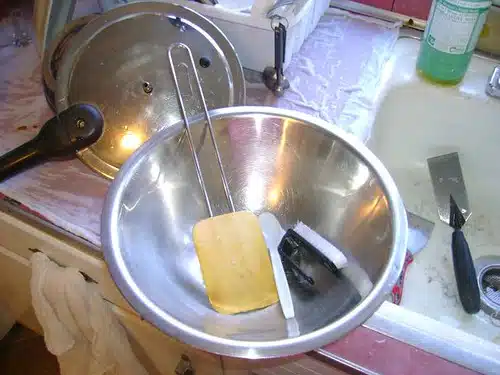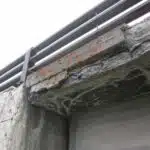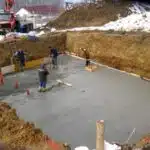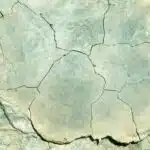As a hydraulic cement specialist, I have had the opportunity to witness firsthand the versatile and useful nature of this material. From sealing leaks in concrete structures to creating new foundations, hydraulic cement has proven itself to be an indispensable tool in the construction industry. In this article, we will explore the various applications of hydraulic cement and provide a step-by-step guide on how to apply it effectively.
Hydraulic cement is a type of cement that sets and hardens when mixed with water. Its unique properties make it ideal for use in situations where traditional cement would not suffice. For example, hydraulic cement can be used to repair cracks in concrete structures or fill voids left behind by deteriorating pipes. Additionally, it is commonly used as a bonding agent between concrete surfaces or as an anchoring material for bolts and other fasteners. By understanding its uses and proper application methods, anyone can take advantage of the benefits of hydraulic cement and improve their construction projects.
An Overview Of Hydraulic Cement
Hydraulic cement is a type of cement that sets and hardens through a chemical reaction with water. Unlike traditional cement, hydraulic cement can set underwater and is ideal for use in environments where there is constant exposure to moisture. One of the significant advantages of hydraulic cement is its quick setting time, which makes it an excellent choice for emergency repairs.
Another advantage of hydraulic cement is its ability to expand slightly as it sets. This expansion helps create a tight seal around cracks or holes in concrete structures, making it an effective solution for repairing leaks. However, one potential drawback to using hydraulic cement is that it can shrink over time, leading to cracks and other structural issues.
When using hydraulic cement, it’s essential to follow best practices carefully. Before application, make sure that the surface you’re repairing is clean and free from debris or loose material. Mix the hydraulic cement according to manufacturer instructions and apply immediately as it sets quickly. It’s also crucial to wear protective gear such as gloves and safety glasses when working with hydraulic cement due to its caustic nature.
Hydraulic cement differs from traditional cement in several ways, including its setting time and ability to set underwater. Understanding these differences will help you determine which type of cement is right for your specific repair needs.
How Hydraulic Cement Differs From Traditional Cement
Hydraulic cement is a type of cement that sets and hardens through a chemical reaction with water, rather than simply drying out like traditional cement. This difference in setting process gives hydraulic cement properties that make it ideal for certain construction scenarios. In comparison to traditional cement, hydraulic cement has several unique benefits.
Firstly, the setting time of hydraulic cement is much faster than traditional cement due to its chemical reaction with water. This makes it a popular choice in construction projects where time is of the essence. Additionally, hydraulic cement has excellent resistance to water and chemicals compared to traditional cement, making it a preferable option in applications such as building foundations or underground structures.
Furthermore, hydraulic cement can be applied even in wet conditions without losing its effectiveness. Traditional cement would require dry conditions to set properly, which can be challenging during rainy seasons or near bodies of water. The ability to apply hydraulic cement in damp environments makes it an attractive option for marine construction and other similar projects.
In conclusion, the usage of hydraulic cement in construction offers several advantages over traditional cement due to its unique properties. It sets quickly through a chemical reaction with water, resists water and chemicals effectively, and can be applied even in damp conditions. These features make it an invaluable tool for many types of construction projects.
Moving forward into discussing the different types of hydraulic cements available…
Types Of Hydraulic Cement
One common objection to the use of hydraulic cement is that it can be difficult to choose the right type for a specific application. However, understanding the different types of hydraulic cement available can help make this decision easier.
There are two main types of hydraulic cement: rapid setting and non shrink. Rapid setting hydraulic cement sets quickly and is ideal for applications where time is of the essence, such as repairing leaks in underground pipes or stopping water flow in a dam. Non shrink hydraulic cement, on the other hand, is designed to maintain its volume during and after hardening. This makes it suitable for use in areas where structural stability is crucial, such as bridges or high-rise buildings.
In addition to different types of hydraulic cement, there are also different applications for its use. Underwater hydraulic cement is specifically formulated to set and harden under water, making it ideal for repairing cracks and leaks in swimming pools or dams. Above ground hydraulic cement is used primarily for patching and repairing concrete surfaces that are exposed to weather conditions such as rain or snow.
Understanding The Chemical Composition Of Hydraulic Cement
Having discussed the different types of hydraulic cement, it is now imperative to understand its chemical composition. Hydraulic cement is made up of a combination of materials such as limestone, clay, iron ore, and gypsum. These materials undergo several chemical reactions during the production process to form a powdered mixture that hardens when mixed with water.
One of the most important factors to consider when using hydraulic cement is its setting time. The setting time refers to the amount of time it takes for the cement to harden after being mixed with water. This depends on various factors such as temperature, humidity, and the specific type of hydraulic cement used. It is important to follow the manufacturer’s instructions regarding mixing ratios and setting times to ensure that the cement sets properly.
Understanding the chemical reactions involved in hydraulic cement production and monitoring its setting time are crucial for achieving optimal results when using this material. Proper application techniques can make all the difference in ensuring that your project is structurally sound and long-lasting. In the subsequent section, we will discuss some advantages of using hydraulic cement over other construction materials.
Advantages Of Using Hydraulic Cement
Using hydraulic cement has its pros and cons. Its main advantage is its ability to withstand water penetration, making it ideal for use in structures exposed to water, such as dams and swimming pools. Additionally, due to its quick-setting nature, hydraulic cement can be used in emergency situations where a fast repair is needed. However, one of the drawbacks of using hydraulic cement is that it cannot be easily removed once it sets. Therefore, it should only be used when permanence is required.
When storing hydraulic cement, it is important to keep it in a cool and dry place. Moisture can cause the cement to set prematurely or weaken over time. The best practice is to store the cement in airtight containers that are not exposed to direct sunlight or extreme temperatures. It is also important to use the oldest stock first and not mix new and old batches together.
In summary, hydraulic cement has numerous advantages that make it an ideal choice for certain applications. However, careful consideration should be given before using this type of cement as removal can be difficult once it sets. Proper storage practices must also be followed to ensure the longevity of the product. In the next section, we will discuss some common applications of hydraulic cement in more detail.
Common Applications Of Hydraulic Cement
The versatility of hydraulic cement renders it an essential material in various construction applications. Its primary benefit is its ability to cure and harden underwater, making it ideal for structures that require water-resistance properties. Hydraulic cement can be used to seal off water leaks in foundations, walls, and floors, preventing water damage that can compromise the structural integrity of a building.
One of the most common uses of hydraulic cement in construction is for waterproofing purposes. It is often applied to concrete surfaces as a barrier against water penetration. This versatile material can be used in both horizontal and vertical applications, including sealing around pipes and conduits that penetrate walls or floors. Additionally, hydraulic cement can be used on masonry surfaces like brick or stone to protect them from moisture intrusion.
In summary, the uses of hydraulic cement are diverse and vital in construction projects. Its excellent waterproofing capabilities make it a go-to material for sealing foundations, walls, and floors. With its ability to cure even when submerged underwater, hydraulic cement is ideal for structures that require water-resistant properties. In the subsequent section, we will discuss how hydraulic cement can be utilized for repairing cracks in concrete structures while maintaining its water-resistant features.
Repairing Cracks In Concrete Structures With Hydraulic Cement
Repairing cracks in concrete structures with hydraulic cement is a common practice in the construction industry. This material is known for its ability to create durable and long-lasting repairs that can withstand harsh environmental conditions. When it comes to repairing concrete floors, hydraulic cement can be used to fill in small cracks and gaps. The process involves cleaning the surface area thoroughly, mixing the hydraulic cement according to the manufacturer’s instructions, and applying it directly onto the crack.
Another application of hydraulic cement is basement waterproofing. It is important to keep basements dry as moisture can cause damage to the structure and promote mold growth. Hydraulic cement can be used to seal any cracks or gaps where water may seep through, creating a barrier that prevents water from entering the basement. To ensure proper application, it is recommended that a professional performs this task.
In addition to repairing cracks and waterproofing basements, hydraulic cement can also be used for filling voids in concrete structures. This process involves cleaning out any debris or loose material from the void, applying a bonding agent, mixing the hydraulic cement according to manufacturer’s instructions, and pouring it into the void. Once dried and cured, the hydraulic cement will create a solid and stable repair that should last for years to come.
Filling Voids With Hydraulic Cement
- Preparing the void space for filling with hydraulic cement is paramount to properly filling the area; it is important to ensure the surface is free of debris and oil, and that the edges of the void are well defined.
- Hydraulic cement is mixed with water to create a slurry paste, and should be applied in several layers to ensure the void space is completely filled.
- Hydraulic cement should be applied with a trowel, pressing the slurry paste firmly into the void space, and smoothing the surface of the cement.
- Once the hydraulic cement has been applied, it should be allowed to dry for at least one hour before the area is exposed to water or other elements.
Preparing The Void
To achieve the desired result of filling voids with hydraulic cement, it is essential to prepare the void properly. Void preparation techniques involve cleaning the area around the void and ensuring that it is free of any loose debris or dirt. This will ensure that the hydraulic cement adheres to the surface and provides a strong bond. Additionally, all cracks should be cleaned and widened before filling with hydraulic cement.
Tools required for preparing the void include a wire brush, chisel, hammer, water, and a vacuum cleaner. The wire brush is useful for removing any loose particles from the surface of the void. The chisel and hammer can be used to widen cracks if necessary. Water is essential for cleaning and mixing with the hydraulic cement powder. Finally, a vacuum cleaner can be used to remove any remaining debris from the surface of the void.
Proper preparation of the void will ensure that your hydraulic cement application is successful in filling in gaps or cracks. Taking care during this step will increase its effectiveness and longevity while providing optimal results over time. With these techniques and tools, you can confidently fill in any gap or crack using hydraulic cement without worrying about future damage or safety concerns.
Applying Hydraulic Cement
After properly preparing the void, the next step is to apply the hydraulic cement. Applying techniques involve mixing the hydraulic cement powder with water to create a thick paste that can be easily spread over the surface of the void. It’s important to follow the manufacturer’s instructions for mixing and applying as different types of hydraulic cement may have different requirements.
One common mistake made during application is not filling the void completely. It’s essential to ensure that no air pockets remain in the space as this can lead to future structural issues. Another common mistake is applying too much hydraulic cement at once, which can cause it to crack or shrink over time. To avoid this, it’s recommended to apply multiple thin layers, allowing each layer to dry before adding more.
After applying, it’s important to allow sufficient time for the hydraulic cement to dry and cure before any weight or pressure is applied on it. This duration may vary depending on factors such as temperature and humidity levels but generally takes around 24-48 hours. Once fully cured, you can sand or paint over the surface if required. By following proper preparation and application techniques while avoiding common mistakes, you can achieve optimal results while filling voids with hydraulic cement effectively and safely.
Using Hydraulic Cement As A Bonding Agent
After filling voids with hydraulic cement, another common use of this material is as a bonding agent. When used as a bonding agent, hydraulic cement offers excellent bonding strength that can be applied to various surfaces such as concrete, stone, and brick. The bonding strength of hydraulic cement is attributed to its ability to expand as it sets, effectively filling any gaps or cracks on the surface.
However, before applying hydraulic cement as a bonding agent, proper surface preparation is crucial. The surface must be clean and free from any debris or loose particles that may affect the adhesion of the hydraulic cement. Any existing coatings or sealants on the surface must also be removed to ensure maximum bond strength between the surface and the hydraulic cement.
In addition to using hydraulic cement for filling voids and as a bonding agent, it can also be used for anchoring materials. In this application, hydraulic cement is used to secure objects in place such as posts and poles by creating a solid foundation that prevents movement over time. In the next section, we will discuss how to properly anchor materials using hydraulic cement without compromising its structural integrity.
Anchoring Materials With Hydraulic Cement
Hydraulic cement is a versatile construction material that is commonly used for foundation repair and waterproofing. Its unique properties enable it to form a strong bond with concrete and other materials, making it an ideal choice for anchoring applications. Here are some of the benefits of using hydraulic cement for anchoring:
- Fast-setting: Hydraulic cement hardens quickly, allowing for rapid repairs and installations.
- Easy to use: It can be mixed with water to create a paste-like consistency that can be easily applied to surfaces.
- Durable: Once set, hydraulic cement forms a strong, durable bond that resists cracking and erosion.
- Versatile: It can be used on various surfaces, including masonry, concrete, and metal.
- Waterproof: When properly applied, hydraulic cement creates a waterproof barrier that prevents water from seeping in.
Using hydraulic cement for anchoring requires careful preparation and application. Before applying the cement, the surface must be clean and free of debris. Any loose or damaged material should be removed to ensure proper adhesion. Additionally, the surface should be moistened before applying the hydraulic cement paste.
To apply the hydraulic cement, mix it with water according to the manufacturer’s instructions until you achieve a thick paste consistency. Use a trowel or putty knife to apply the paste evenly over the surface. The thickness of the layer will depend on the application requirements.
In preparing surfaces for applying hydraulic cement for anchoring materials, proper steps must be taken before proceeding with mixing and applying it onto any structure. By following these steps carefully, you can ensure successful outcomes in your project.
Preparing The Surface For Application
After anchoring materials with hydraulic cement, the next step is to prepare the surface for application. This is a critical step as it ensures maximum adhesion and longevity of the hydraulic cement. Surface preparation techniques include removing any loose or deteriorated concrete, cleaning the surface thoroughly, and creating a rough texture by either shotblasting or acid-etching.
One common mistake to avoid when preparing surfaces for hydraulic cement application is failing to remove all loose or deteriorated concrete. This can lead to poor adhesion and ultimately result in failure of the hydraulic cement repair. Another mistake is not cleaning the surface properly, which can cause dirt and debris to interfere with adhesion. Additionally, not creating a rough enough surface texture can also lead to poor adhesion between the substrate and hydraulic cement.
Proper surface preparation is crucial for successful application of hydraulic cement. By avoiding common mistakes such as leaving loose concrete or failing to clean the surface correctly, you can ensure maximum adhesion and longevity of your repair. Next, we will discuss how to mix hydraulic cement for optimal results.
Mixing Hydraulic Cement
As a hydraulic cement specialist, it is essential to understand the proper mixing techniques for this material. The first step in mixing hydraulic cement is to add clean water to the dry mix. It is recommended to use cold water for mixing, as warm or hot water can cause the cement to set too quickly. Use a clean container and ensure that the water-to-cement ratio is appropriate for the specific type of hydraulic cement being used.
One of the most common mistakes when mixing hydraulic cement is adding too much water. This can result in a weaker mixture with less durability and strength. It is crucial to follow manufacturer instructions carefully and only add enough water until a smooth consistency is achieved. Over-mixing can also lead to issues, so be sure not to mix longer than necessary.
Another important tip when mixing hydraulic cement is to avoid introducing any contaminants into the mixture. Keep tools and containers clean, and do not use materials such as oil or grease during the process. By following these simple mixing techniques and avoiding common mistakes, you can ensure that your hydraulic cement mixture will be strong, durable, and long-lasting.
Transition:
Now that you have mastered the proper mixing techniques for hydraulic cement, it’s time to move on to applying this versatile material effectively.
Applying Hydraulic Cement
Applying hydraulic cement requires a careful and precise approach to ensure that the material adheres properly and creates a strong bond. To begin, it is important to have the necessary tools on hand. These may include a trowel, mixing bucket, water, and any other materials needed for the specific application. It is also crucial to wear appropriate protective gear, such as gloves and goggles.
One common mistake when applying hydraulic cement is not properly mixing the material. It is essential to follow the manufacturer’s instructions for mixing ratios and time frames. Overmixing or undermixing can lead to weak bonds or cracking. Another mistake is not properly preparing the surface before applying the cement. The surface should be clean, dry, and free of any loose debris or contaminants.
When applying hydraulic cement, it is important to work quickly but carefully. The material sets rapidly, so it is essential to only mix small amounts at a time and apply them immediately. Use a trowel or other appropriate tool to apply the cement evenly in thin layers, ensuring that it covers all areas needing repair or reinforcement. With these techniques in mind, one can effectively apply hydraulic cement with confidence.
Transition: Now that we have covered applying hydraulic cement correctly let us move on to curing and finishing techniques that will ensure optimal results for your project.
Curing And Finishing Hydraulic Cement
Curing and finishing hydraulic cement is an essential aspect of the application process. Neglecting these crucial steps can lead to a compromised structural integrity, decreased durability, and premature failure of the concrete structure. Therefore, it is imperative to follow the correct curing techniques and surface preparation methods to ensure optimal results.
Curing Techniques: Proper curing is critical for achieving maximum strength and durability in hydraulic cement. This process involves keeping the concrete moist for an extended period to allow the hydration process to occur fully. Some popular methods include sealing the concrete with a plastic sheet, wetting it with water regularly, or covering it with wet burlap. Depending on weather conditions, curing time may vary from a few days to several weeks.
Surface Preparation: Adequate surface preparation is also essential before applying hydraulic cement. It involves cleaning any debris or loose particles from the surface while ensuring that it’s free from oil, grease, or any other contaminants that may affect adhesion. Surface roughness also plays a role in enhancing adhesion between old and new concrete surfaces.
In summary, proper curing and surface preparation are critical aspects of working with hydraulic cement. Neglecting these steps can lead to significant problems in terms of structural integrity and durability. Therefore, it’s important always to follow recommended best practices when working with this material. The next section will provide tips on how to work effectively with hydraulic cement.
Tips For Working With Hydraulic Cement
After properly curing and finishing hydraulic cement, the next step is to ensure that it doesn’t crack during use. One of the most common mistakes when working with hydraulic cement is adding too much water. This can lead to a weaker final product and increase the likelihood of cracking. To prevent this, it’s important to follow the manufacturer’s instructions for mixing ratios and not deviate from them.
Another tip for preventing cracking is to apply the hydraulic cement in thin layers rather than one thick layer. This allows each layer to properly set before adding more, reducing stress on the material and decreasing the risk of cracks forming. Additionally, it’s important to keep an eye on any joints or edges where the hydraulic cement meets other materials as these areas are more prone to cracking.
Common mistakes when using hydraulic cement also include not properly cleaning and preparing surfaces before application, failing to apply a bonding agent between layers or when applying over existing concrete, and not allowing enough time for curing before subjecting the material to stress or weight. By following these tips and avoiding these common mistakes, users can ensure that their hydraulic cement remains strong and durable with minimal risk of cracking.
With proper preparation and application techniques, hydraulic cement can be a reliable solution for a variety of construction needs. However, it’s important to take care when working with this material in order to prevent any issues down the line. By keeping these tips in mind and avoiding common mistakes, users can ensure that their projects are completed successfully with long-lasting results.
Conclusion
Hydraulic cement is a versatile and durable material that has been used in construction for many years. Its unique properties make it an ideal choice for a wide range of applications, including repairing cracks, sealing leaks, and anchoring machinery. Unlike traditional cement, hydraulic cement sets quickly and hardens even underwater. There are several types of hydraulic cement available on the market today, each with its own specific properties and uses. Understanding the chemical composition of hydraulic cement is essential to choosing the right type for your project. One advantage of using hydraulic cement is its ability to expand slightly as it sets, creating a tight seal against water intrusion. However, it’s important to follow proper mixing and application techniques to ensure that the cement sets properly without cracking or shrinking.
Mixing hydraulic cement requires careful attention to water-to-cement ratios and thorough blending to avoid lumps or uneven consistency. When applying hydraulic cement, be sure to work quickly as it sets rapidly once mixed with water. Curing time can vary depending on temperature and humidity levels but typically ranges from a few hours to several days. As a specialist in hydraulic cement applications, I recommend taking the time to learn about this remarkable material’s unique properties before attempting any DIY projects. With proper preparation and attention to detail, anyone can use hydraulic cement with confidence to create long-lasting repairs or secure anchoring solutions. In conclusion, like a river constantly flowing towards its destination, hydraulic cement flows smoothly into cracks and crevices where it hardens into an unyielding barrier that prevents further damage from occurring. This versatile material is not just useful in construction but also in artistry where it can be sculpted into beautiful designs that stand the test of time. As you venture forth into your next project involving hydraulic cement remember this metaphorical image of a river flowing steadily onward towards completion; apply yourself fully with patience and precision- let the natural flow guide you towards success!
Image Credits
- “Mixing hydraulic cement” by tuckasegee (featured)





























